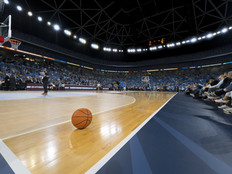PC's Creative Side

For three long hours, Bob Lloyd waited. He waited as the creators of “South Park” gave their acceptance speech. He waited as Bobby Cannavale collected the Emmy for his role on “Will & Grace.” Then, as the nominees were named for outstanding special visual effects, Lloyd’s heart beat a little faster.
“It seemed like everything went into slow motion,” says Lloyd, who took home the Emmy for his work on the “Lost” pilot and was nominated again the following year. “They call your name, and as you walk up to the stage, it just seems sort of surreal.”
Lloyd’s surreal journey to the Emmy stage began long before he put on his tux. He got his start “playing around” with PCs in the early 1990s and got good enough to start a one-man visual effects business in 1998. Sitting at home, working on PCs he custom built and using standard software such as Adobe Photoshop and After Effects, Lloyd is the creative force behind the visual effects you see on blockbusters such as “Alias,” “24,” “Mission: Impossible 3” and the upcoming “Live Free or Die Hard” (Die Hard 4).
While the stereotype persists that Macs are for creative types and PCs are for business, the reality is that artists and dreamers of all stripes have reached new heights armed with a PC, an idea and determination.
“PC technology has become so powerful,” says Dr. C.P. Jois, director of technology services at Aquent IT Solutions in Chicago. “The opportunities are limitless and the avenues are infinite. You’re only limited by your imagination.”
He would know. A lifelong flight enthusiast, Jois transformed his basement into a virtual Boeing 737 using old PCs, network switches, off-the-shelf software and a homemade physical structure built nearly to the scale of a Boeing 737 cockpit.
“He has the pilot and co-pilot seats, a whole control panel and networked computer screens, so that when it runs, you’re getting this panoramic view,” says Ram Narain, a project manager at IBM and friend of Jois. “That whole experience of using a computer has been taken out.”
Examples abound of PC users who push the boundaries of creativity. Whether they’re flying virtual planes from O’Hare to Heathrow (737ngsimulator.com) or crashing them into deserted islands (fuzzylogicproductions.net), these mavericks are living proof that PC users are anything but stuffed shirts.
High Flyer
In 1986, Jois’ father bought an IBM PC XT. After a friend gave Jois a copy of Microsoft Simulator 2, he combed the streets of Bombay looking for an instruction manual. He eventually scored a cryptic 20-page booklet that he still cherishes today. “That was when I first experienced what it was like to fly a plane on the PC,” he recalls.
Jois went on to work for United Airlines, managing information systems for flight and airport operations. All the while, he bought every upgrade to Flight Simulator, but he always felt limited. Using a mouse, keyboard or joystick to remove the landing gear or lift the flaps of the plane was a constant reminder that he was operating a computer instead of an airplane.

He wanted to replace those tools with actual plane controls and add the sights, sounds and movements of a real plane. “The fundamental question was, ‘Is that possible?’” Jois says. “Can you extend the limits of PC flight simulation?”
Jois knew he could. He just needed to figure out how to bring it to life. “There’s no blueprint to fetch and go make this happen,” he explains. “I’d wake in the middle of the night with an idea and get to work, trying not to wake up the neighborhood.”
There are three aspects to Jois’ simulator: the physical wooden structure; the key hardware, such as knobs, levers, PCs and network switches; and software.
The core flight software is Microsoft Flight Simulator loaded onto an Intel Core Duo Processor PC that Jois bought in December. He loaded nine old PCs with software to simulate the views and connect them to the gauges used to fly the plane.
Jois used basic Transport Control Protocol/Internet Protocol (TCP/IP) and networking switches to distribute the computing loads so the views would react instantly to the instrumentation. To split images across multiple screens, Jois integrated graphics software from Project Magenta in Germany. He focused on building the simulator one piece at a time, testing and retesting every element along the way.
“Optimizing the network is an ongoing process,” Jois says. “I want to feel like I’m flying instead of operating nine PCs.”
Inside Jois’ “airplane,” the pilot and co-pilot can hear the sound of the landing gear when they lower the lever and hear the engine roar when they adjust the throttle. To further enhance the experience, the simulation provides virtual air-traffic control instructions. They can adjust the parameters of their “flights” to include severe weather conditions.
What drove him to such exacting standards? “Initially, it was to prove to myself that PC-based flight simulation could be this real,” Jois says. “But there have been other goals.”
He’s considered consulting others who are building simulators or developing a do-it-yourself kit. Ideally, he’d like to open a library or museum of aviation to teach others, especially children, about how humans came to fly. Jois’ wife, Simi, says others can learn just from watching her husband’s commitment to this project.
“When I look at it, I’m very proud,” she says. “Every individual must have a hobby or a passion. A lot of people dream about something, but to realize it takes a lot of hard work.”
And the Winner Is …
In the pilot episode of “Lost,” an airplane in mid-flight begins to tear apart and spiral out of control. For those still haunted by that scene, fear not. It was created on a PC.
When a TV show or movie blows up a car on set or has a mechanical shark attack beachgoers, that’s a special effect. When the shot is created post-production on a computer, that’s a visual effect. Early visual effects, like the space scenes in “Star Wars,” were created by large companies that could afford to buy the expensive graphics equipment. “Guys like me obviously weren’t going to spend $100,000 for hardware and a piece of software,” Lloyd says.
But an interesting shift occurred. The PC revolution made computers affordable for the average Joe, and software makers such as Adobe came out with inexpensive off-the-shelf software capable of achieving visual effects on par with the big industry players.
But how does a one-man visual effects shop get the attention of Hollywood’s biggest productions? “Cost,” Lloyd explains. “I have no overhead.” He works from home, trading video clips with clients via e-mail or having them download File Transport Protocol (FTP) files from secure sites.
For some projects, Lloyd works solo. Other times, he’s on set, managing a project staff of up to 20 visual effects artists. His work can range from removing the wires tethering a stunt double to the top of a moving truck to augmenting the impact and debris of a small on-set explosion, to taking boats out of the background from a scene from “Lost.”
One example of Lloyd’s use of visual effects is when the characters from “The Unit” got stuck in an elevator car and had to climb down the shaft. The actors were really climbing down a set with a green screen behind them. The elevator shaft, created by Lloyd on his PC, was added to the background during post-production.
“If I look at something I did five years ago, it wouldn’t pass now,” Lloyd says. “The technology just keeps getting better.”






